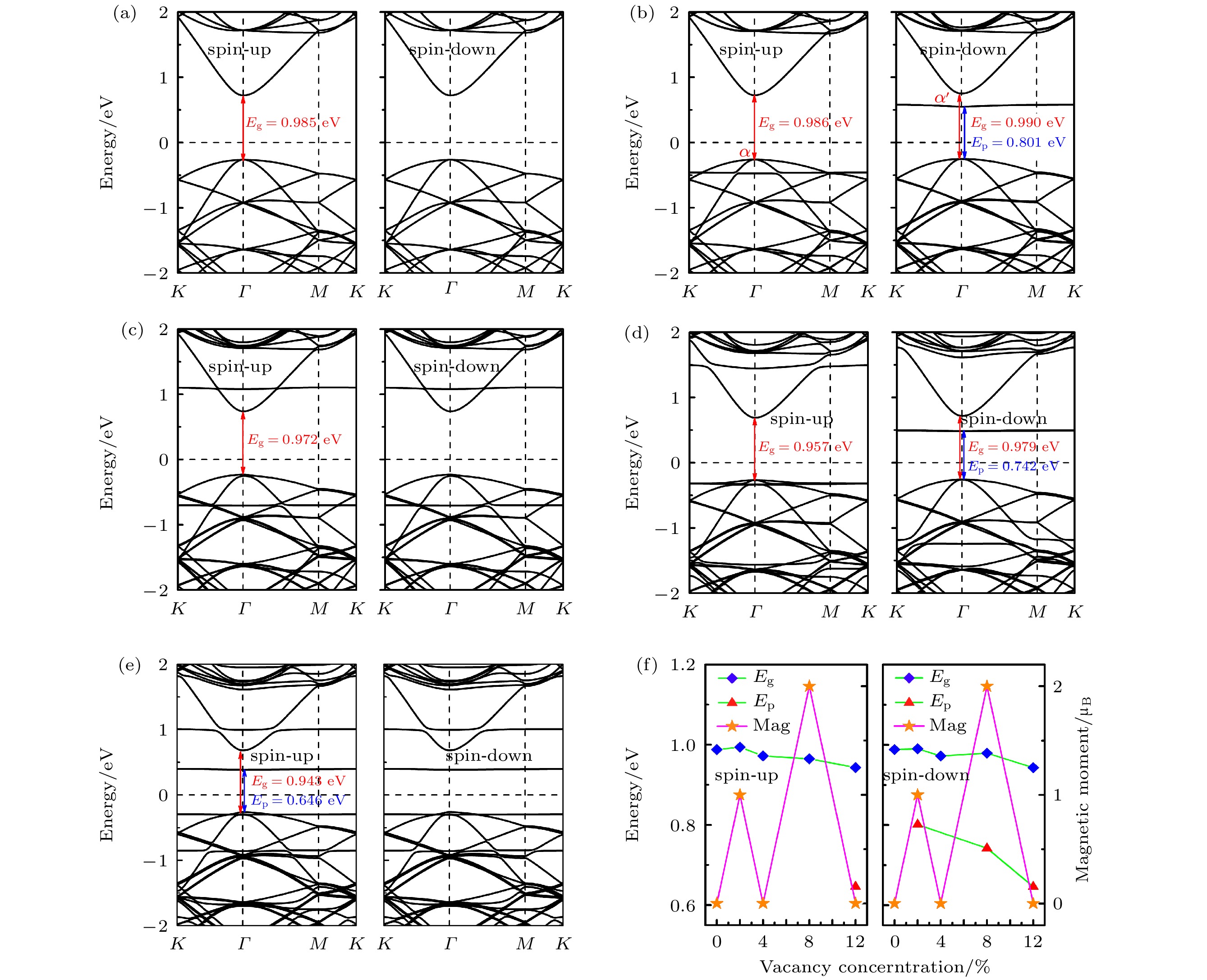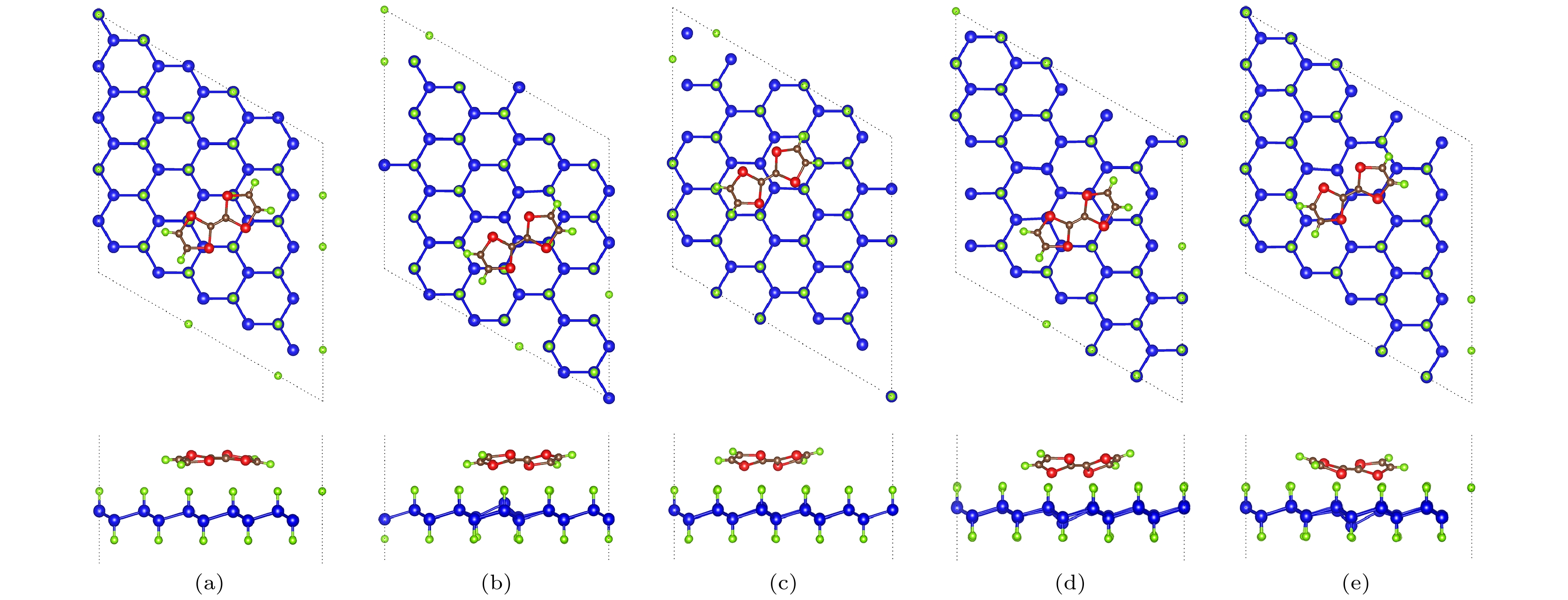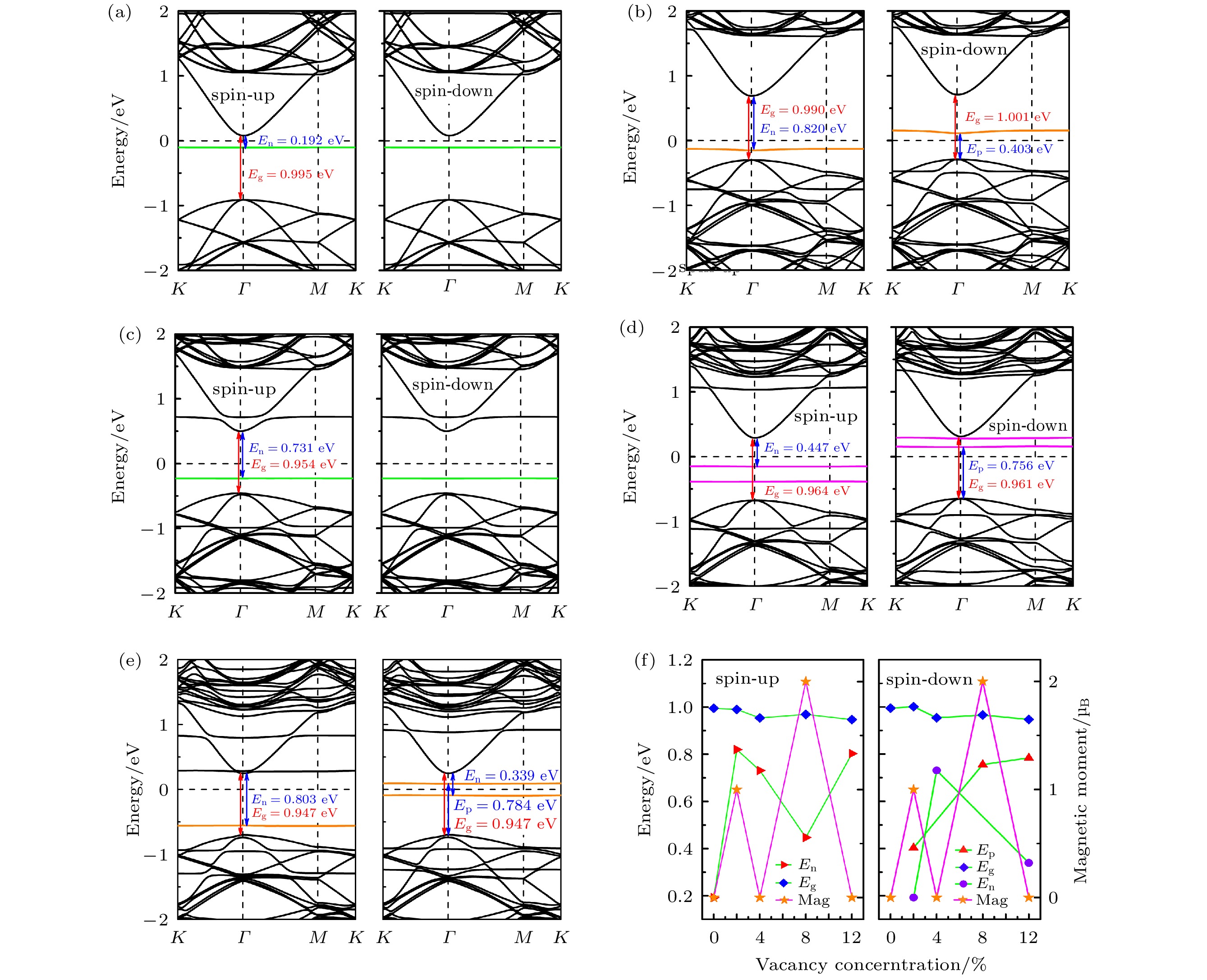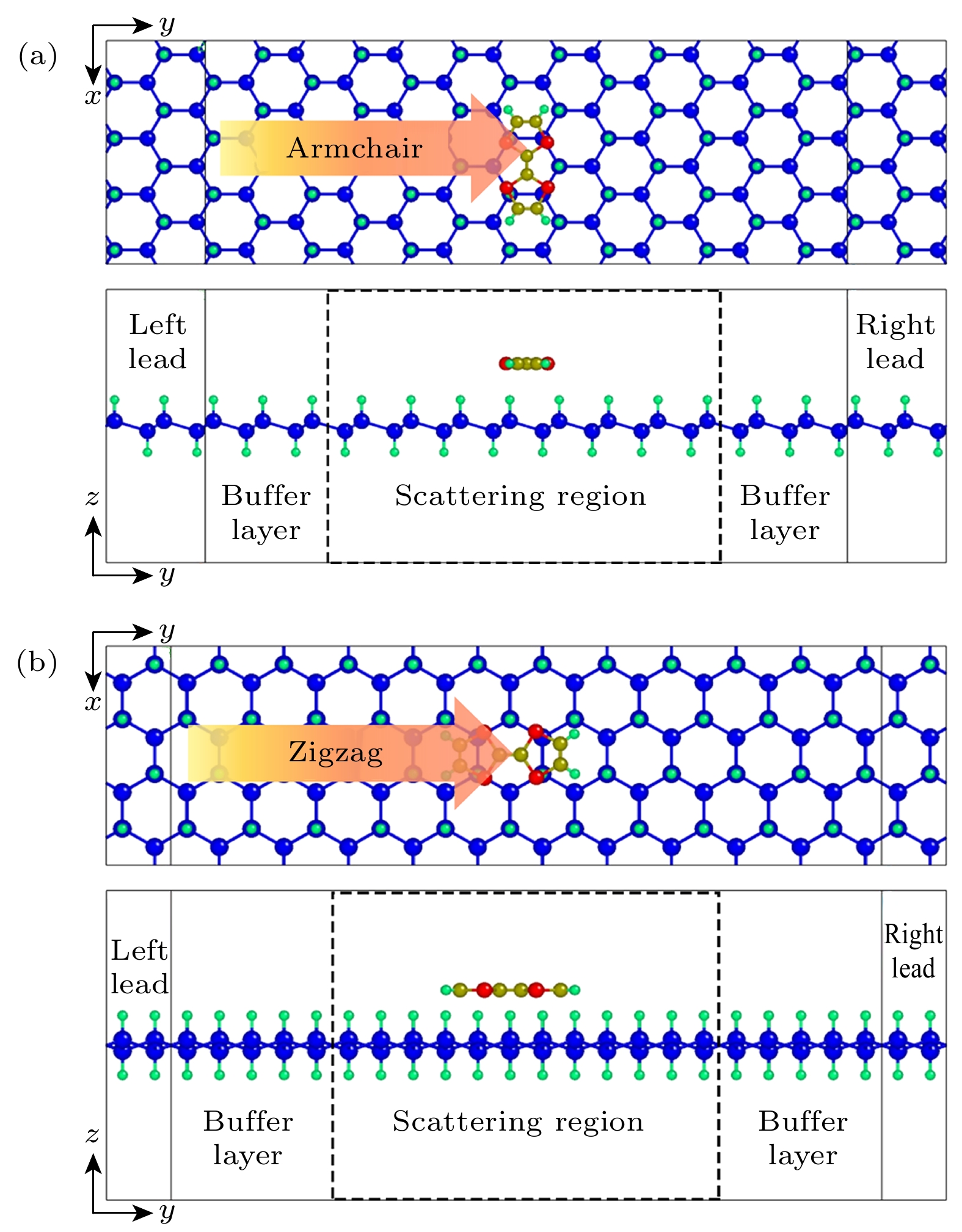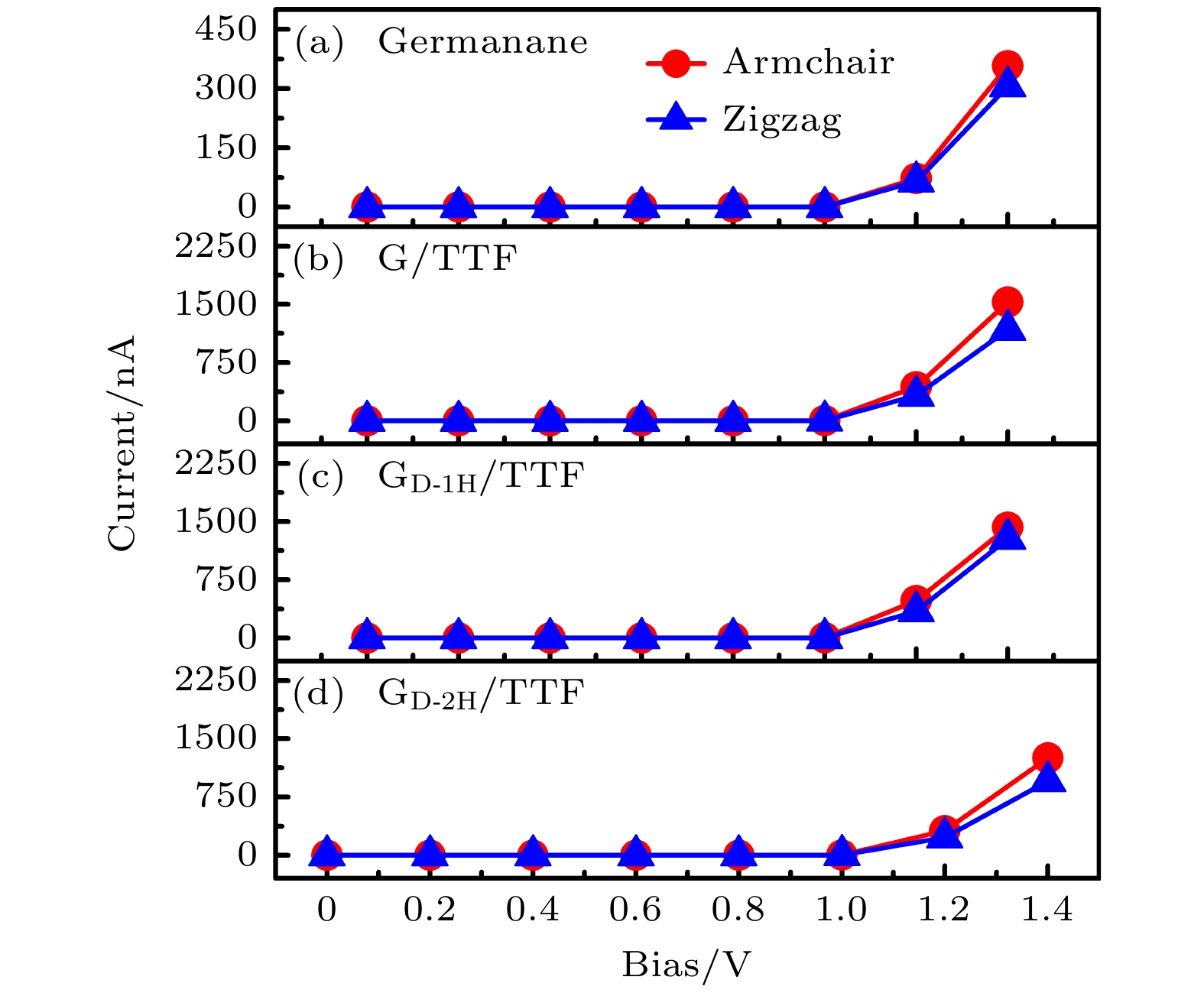-
Germanane is expected to substitute for existing silicon-based or germanium-based material. Germanane is regarded as an ideal candidate for next-generation semiconductor material due to its suitable band gap, high electron mobility, better environmental stability, small electrical noise and ultrathin geometry. In this work, the effects of different configuration and concentration of hydrogen vacancy cluster on the electronic properties of germanane and its molecular doping are systematically investigated through the first-principles method based on density functional theory and none-quilibrium Green’s function. The results show that the hydrogen vacancy clusters with different configurations can induce magnetism with different characteristics in GermananeDehydrogenated-xH (GD-xH) system, and the magnetic moments are consistent with the predictions of Lieb’s theorem. Moreover, the p-type-liked doping effects caused by defective state under GD-xH (x = 1, 4, 6) systems can be realized in their spin-down band structures. The corresponding energy values for exciting electron would gradually decrease with the increase of the concentration of hydrogen vacancy clusters under different configurations. After adsorbing tetrathiafulvalene (TTF) molecules, G/TTF and GD-xH/TTF (x = 1, 2, 6) systems exhibit molecular doping characteristics induced by the TTF molecules. More importantly, for GD-xH/TTF (x = 1, 6) system, the different molecular doping types can be introduced in spin-up and spin-down band structures due to the hybridization composed of molecular orbitals and defective states under spin polarization. Further calculations of their transport properties indicate that germanane-based device with Armchair and Zigzag configurations both exhibit intensive isotropy, and the performance of I-V characteristics can be dramatically enhanced owing to the carrier doping by TTF adsorption.
-
Keywords:
- germanane /
- defect /
- molecular adsorption /
- electronic properties
[1] Novoselov K S, Geim A K, Morozov S V, Jiang D, Zhang Y, Dubonos S V, Grigorieva I V, Firsov A A 2004 Science 306 666
 Google Scholar
Google Scholar
[2] Zhang Y, Tan Y W, Stormer H L, Kim P 2005 Nature 438 201
 Google Scholar
Google Scholar
[3] Novoselov K S, Geim A K, Morozov S V, Jiang D, Katsnelson M I, Grigorieva I V, Dubonos S V, Firsov A A 2005 Nature 438 197
 Google Scholar
Google Scholar
[4] Du X, Skachko I, Barker A, Andrei E Y 2008 Nat. Nanotechnol. 3 491
 Google Scholar
Google Scholar
[5] Bianco E, Butler S, Jiang S, Restrepo O D, Windl W, Goldberger J E 2013 ACS Nano 7 4414
 Google Scholar
Google Scholar
[6] Sahoo N G, Esteves R J, Punetha V D, Pestov D, Arachchige I U, McLeskey J T 2016 Appl. Phys. Lett. 109 023507
 Google Scholar
Google Scholar
[7] Madhushankar B N, Kaverzin A, Giousis T, Potsi G, Gournis D, Rudolf P, Blake G R, van der Wal C H, van Wees B J 2017 2D Mater. 4 021009
 Google Scholar
Google Scholar
[8] Hu L, Zhao J, Yang J 2014 J. Phys. Condens. Matter. 26 335302
 Google Scholar
Google Scholar
[9] Li Y, Chen Z 2014 J. Phys. Chem. C 118 1148
 Google Scholar
Google Scholar
[10] Ma Y, Dai Y, Lu Y B, Huang B 2014 J. Mater. Chem. C 2 1125
 Google Scholar
Google Scholar
[11] Zhou Y, Liu K, Xiao H, Xiang X, Nie J, Li S, Huang H, Zu X 2015 J. Mater. Chem. C 3 3128
 Google Scholar
Google Scholar
[12] Zhao J, Zeng H 2016 RSC Adv. 6 28298
 Google Scholar
Google Scholar
[13] Chandiramouli R 2017 J. Mol. Liq. 242 571
 Google Scholar
Google Scholar
[14] Kannan V, Ganesan V, Vijayakumar V 2022 Comput. Theor. Chem. 1214 113799
 Google Scholar
Google Scholar
[15] Vajda S, Pellin M J, Greeley J P, Marshall C L, Curtiss L A, Ballentine G A, Elam J W, Catillon-Mucherie S, Redfern P C, Mehmood F, Zapol P 2009 Nat. Mater. 8 213
 Google Scholar
Google Scholar
[16] Zhou S, Zhao J 2016 J. Phys. Chem. C 120 21691
 Google Scholar
Google Scholar
[17] Wang X, Liu G, Liu R F, Luo W W, Wu M S, Sun B Z, Lei X L, Ouyang C Y, Xu B 2018 Nanotechnology 29 465202
 Google Scholar
Google Scholar
[18] Cui Z, Luo Y, Yu J, Xu Y 2021 Physica E 134 114873
 Google Scholar
Google Scholar
[19] Yan H, Ma W 2022 Adv. Funct. Mater. 32 2111351
 Google Scholar
Google Scholar
[20] Qin Z, Gao C, Wong W W H, Riede M K, Wang T, Dong H, Zhen Y, Hu W 2020 J. Mater. Chem. C 8 14996
 Google Scholar
Google Scholar
[21] Ye J P, Liu G, Han Y, Luo W W, Sun B Z, Lei X L, Xu B, Ouyang C Y, Zhang H L 2019 Phys. Chem. Chem. Phys. 21 20287
 Google Scholar
Google Scholar
[22] Blöchl P E 1994 Phys. Rev. B 50 17953
 Google Scholar
Google Scholar
[23] Kresse G, Furthmüller J 1996 Phys. Rev. B 54 11169
 Google Scholar
Google Scholar
[24] Monkhorst H J, Pack J D 1976 Phys. Rev. B 13 5188
 Google Scholar
Google Scholar
[25] Grimme S, Antony J, Ehrlich S, Krieg H 2010 J. Chem. Phys. 132 154104
 Google Scholar
Google Scholar
[26] Henkelman G, Arnaldsson A, Jónsson H 2006 Comput. Mater. Sci. 36 354
 Google Scholar
Google Scholar
[27] Taylor J, Guo H, Wang J 2001 Phys. Rev. B 63 245407
 Google Scholar
Google Scholar
[28] Brandbyge M, Mozos J L, Ordejón P, Taylor J, Stokbro K 2002 Phys. Rev. B 65 165401
 Google Scholar
Google Scholar
[29] Yang W, Cao Y, Han J, Lin X, Wang X, Wei G, Lv C, Bournel A, Zhao W 2021 Nanoscale 13 862
 Google Scholar
Google Scholar
[30] Ali M, Pi X, Liu Y, Yang D 2017 AIP Adv. 7 045308
 Google Scholar
Google Scholar
[31] Kuklin A V, Begunovich L V, Gao L, Zhang H, Ågren H 2021 Phys. Rev. B 104 134109
 Google Scholar
Google Scholar
[32] 黄炳铨, 周铁戈, 吴道雄, 张召富, 李百奎 2019 物理学报 68 246301
 Google Scholar
Google Scholar
Huang B Q, Zhou T G, Wu D X, Zhang Z F, Li B K 2019 Acta Phys. Sin. 68 246301
 Google Scholar
Google Scholar
[33] Hongzhiwei Technology 2021 Device Studio (Version 2021B) (Shanghai)
[34] 武红, 李峰 2016 物理学报 65 096801
 Google Scholar
Google Scholar
Wu H, Li F 2016 Acta Phys. Sin. 65 096801
 Google Scholar
Google Scholar
[35] Liu L, Ji Y, Liu L 2019 Bull. Mater. Sci. 42 157
 Google Scholar
Google Scholar
[36] Lieb E H 1989 Phys. Rev. Lett. 62 1201
 Google Scholar
Google Scholar
[37] Neto A H C, Guinea F, Peres N M R, Novoselov K S, Geim A K 2009 Rev. Mod. Phys. 81 109
 Google Scholar
Google Scholar
[38] Kiriya D, Tosun M, Zhao P, Kang J S, Javey A 2014 J. Am. Chem. Soc. 136 7853
 Google Scholar
Google Scholar
-
图 3 G/TTF和GD\text{-}xH/TTF (x = 1, 2, 4, 6)体系最佳吸附构型的俯视图和侧视图 (a) G/TTF, H2-site; (b) GD-1H/TTF, V2-side; (c) GD-2H/TTF, B2-side; (d) GD-4H/TTF, H2-side; (e) GD-6H/TTF, V2-side. 蓝色、绿色、红色和棕色小球分别代表Ge, H, S和C原子
Figure 3. Top and side views of optimal adsorption configuration of G/TTF and GD–xH/TTF (x = 1, 2, 4, 6) systems : (a) G/TTF, H2-site; (b) GD-1H/TTF, V2-side; (c) GD-2H/TTF, B2-side; (d) GD-4H/TTF, H2-side; (e) GD-6H/TTF, V2-side. Blue, green, red and brown spheres represent Ge, H, S, and C atoms, respectively.
图 4 (a) G/TTF和 (b)—(e) GD-xH/TTF (x = 1, 2, 4, 6)体系对应能带结构, 其中绿色和粉色平带分别代表由TTF分子贡献和脱氢处的Ge原子贡献, 橙色平带代表由TTF分子和脱氢处Ge原子共同贡献; (f) Eg, En, Ep和体系净磁矩随脱氢浓度的变化
Figure 4. Corresponding band structures of (a) G/TTF and (b)–(e) GD-xH/TTF (x = 1, 2, 4, 6) systems, where green and pink flat bands represent contribution of TTF molecule and Ge atoms at dehydrogenation, respectively, orange flat bands represent the joint contribution of TTF molecule and Ge atom at dehydrogenation; (f) Eg, En, Ep and magnetic moment as a function of dehydrogenation concentration.
图 6 (a)—(e) G/TTF和GD-xH/TTF (x = 1, 2, 4, 6)体系的差分电荷密度俯视和侧视图, 其中青色和黄色分别代表失电荷和得电荷; 等值面设为0.0002 e/Å3 (a)和 0.001 e/Å3 (b)—(e)
Figure 6. (a)–(e) Top and side views of differential charge density for G/TTF and GD–xH/TTF (x = 1, 2, 4, 6) systems. Cyan and yellow color represents deficiency and accumulation of electron, respectively. Isosurface is set to 0.0002 e/Å3 and 0.001 e/Å3 in panel (a) and (b)–(e), respectively.
图 8 Armchair (a)和Zigzag(b)类型的锗烷纳米器件模型的电子透射谱和态密度图, 其中蓝色实线表示透射谱曲线, 绿色虚线表示态密度
Figure 8. Electron transmission spectra and DOS along Armchair (a) and Zigzag (b) directions in germanane-based nanodevice model. Blue implementation represents the transmission spectral curve, and the green dashed line represents the DOS.
表 1 本征锗烷和脱氢锗烷的磁矩、Ge—H键长、Ge—Ge键长以及Ge原子的平均褶皱高度
Table 1. Magnetic moment, Ge—H bond length, Ge—Ge bond length and the average height of the Ge atoms in different configurations of dehydrogenated germanane.
参数 Germanane GD-1H GD-2H GD-4H GD-6H $ \mu /{\mu }_{{\rm{B}}} $ 0 1.000 0 2.000 0 ${d}_{ {\rm{G} }{\rm{e} }\text{—}{\rm{H} } }/$Å 1.561 1.561—1.568 1.562—1.567 1.562—1.567 1.564—1.570 ${d}_{ {\rm{G} }{\rm{e} }\text{—}{\rm{G} }{\rm{e} } }$/Å 2.467 2.465—2.487 2.345—2.493 2.430—2.492 2.415—2.492 Δ/Å 0.725 0.726 0.733 0.734 0.735 表 2 G/TTF和GD-xH/TTF (x = 1, 2, 4, 6)体系最佳吸附构型所对应的吸附能, 净磁矩, 结构参数和电荷转移量
Table 2. Adsorption energy, magnetic moment, structural parameters and charge transfer of optimal adsorption configuration of G/TTF and GD-xH/TTF (x = 1, 2, 4, 6) systems.
参数 G/TTF GD-1H/TTF GD-2H/TTF GD-4H/TTF GD-6H/TTF $ {E}_{{\rm{a}}{\rm{d}}} $/eV 0.583 0.889 0.766 0.895 1.230 $ \mu $/$ {\mu }_{{\rm{B}}} $ 0 1.000 0 2.000 0 d/Å 4.592 4.294 4.307 3.737 3.527 ${d}_{ {\rm{G} }{\rm{e} }\text{—}{\rm{G} }{\rm{e} } }$/Å 2.468—2.470 2.467—2.523 2.384—2.501 2.469—2.506 2.423—2.517 ${d}_{ {\rm{G} }{\rm{e} }\text{—}{\rm{H} } }$/Å 1.560—1.568 1.563—1.571 1.563—1.571 1.563—1.577 1.563—1.570 Δ/Å 0.735 0.738 0.734 0.739 0.736 Q/e 0.029 0.392 0.195 0.230 0.200 -
[1] Novoselov K S, Geim A K, Morozov S V, Jiang D, Zhang Y, Dubonos S V, Grigorieva I V, Firsov A A 2004 Science 306 666
 Google Scholar
Google Scholar
[2] Zhang Y, Tan Y W, Stormer H L, Kim P 2005 Nature 438 201
 Google Scholar
Google Scholar
[3] Novoselov K S, Geim A K, Morozov S V, Jiang D, Katsnelson M I, Grigorieva I V, Dubonos S V, Firsov A A 2005 Nature 438 197
 Google Scholar
Google Scholar
[4] Du X, Skachko I, Barker A, Andrei E Y 2008 Nat. Nanotechnol. 3 491
 Google Scholar
Google Scholar
[5] Bianco E, Butler S, Jiang S, Restrepo O D, Windl W, Goldberger J E 2013 ACS Nano 7 4414
 Google Scholar
Google Scholar
[6] Sahoo N G, Esteves R J, Punetha V D, Pestov D, Arachchige I U, McLeskey J T 2016 Appl. Phys. Lett. 109 023507
 Google Scholar
Google Scholar
[7] Madhushankar B N, Kaverzin A, Giousis T, Potsi G, Gournis D, Rudolf P, Blake G R, van der Wal C H, van Wees B J 2017 2D Mater. 4 021009
 Google Scholar
Google Scholar
[8] Hu L, Zhao J, Yang J 2014 J. Phys. Condens. Matter. 26 335302
 Google Scholar
Google Scholar
[9] Li Y, Chen Z 2014 J. Phys. Chem. C 118 1148
 Google Scholar
Google Scholar
[10] Ma Y, Dai Y, Lu Y B, Huang B 2014 J. Mater. Chem. C 2 1125
 Google Scholar
Google Scholar
[11] Zhou Y, Liu K, Xiao H, Xiang X, Nie J, Li S, Huang H, Zu X 2015 J. Mater. Chem. C 3 3128
 Google Scholar
Google Scholar
[12] Zhao J, Zeng H 2016 RSC Adv. 6 28298
 Google Scholar
Google Scholar
[13] Chandiramouli R 2017 J. Mol. Liq. 242 571
 Google Scholar
Google Scholar
[14] Kannan V, Ganesan V, Vijayakumar V 2022 Comput. Theor. Chem. 1214 113799
 Google Scholar
Google Scholar
[15] Vajda S, Pellin M J, Greeley J P, Marshall C L, Curtiss L A, Ballentine G A, Elam J W, Catillon-Mucherie S, Redfern P C, Mehmood F, Zapol P 2009 Nat. Mater. 8 213
 Google Scholar
Google Scholar
[16] Zhou S, Zhao J 2016 J. Phys. Chem. C 120 21691
 Google Scholar
Google Scholar
[17] Wang X, Liu G, Liu R F, Luo W W, Wu M S, Sun B Z, Lei X L, Ouyang C Y, Xu B 2018 Nanotechnology 29 465202
 Google Scholar
Google Scholar
[18] Cui Z, Luo Y, Yu J, Xu Y 2021 Physica E 134 114873
 Google Scholar
Google Scholar
[19] Yan H, Ma W 2022 Adv. Funct. Mater. 32 2111351
 Google Scholar
Google Scholar
[20] Qin Z, Gao C, Wong W W H, Riede M K, Wang T, Dong H, Zhen Y, Hu W 2020 J. Mater. Chem. C 8 14996
 Google Scholar
Google Scholar
[21] Ye J P, Liu G, Han Y, Luo W W, Sun B Z, Lei X L, Xu B, Ouyang C Y, Zhang H L 2019 Phys. Chem. Chem. Phys. 21 20287
 Google Scholar
Google Scholar
[22] Blöchl P E 1994 Phys. Rev. B 50 17953
 Google Scholar
Google Scholar
[23] Kresse G, Furthmüller J 1996 Phys. Rev. B 54 11169
 Google Scholar
Google Scholar
[24] Monkhorst H J, Pack J D 1976 Phys. Rev. B 13 5188
 Google Scholar
Google Scholar
[25] Grimme S, Antony J, Ehrlich S, Krieg H 2010 J. Chem. Phys. 132 154104
 Google Scholar
Google Scholar
[26] Henkelman G, Arnaldsson A, Jónsson H 2006 Comput. Mater. Sci. 36 354
 Google Scholar
Google Scholar
[27] Taylor J, Guo H, Wang J 2001 Phys. Rev. B 63 245407
 Google Scholar
Google Scholar
[28] Brandbyge M, Mozos J L, Ordejón P, Taylor J, Stokbro K 2002 Phys. Rev. B 65 165401
 Google Scholar
Google Scholar
[29] Yang W, Cao Y, Han J, Lin X, Wang X, Wei G, Lv C, Bournel A, Zhao W 2021 Nanoscale 13 862
 Google Scholar
Google Scholar
[30] Ali M, Pi X, Liu Y, Yang D 2017 AIP Adv. 7 045308
 Google Scholar
Google Scholar
[31] Kuklin A V, Begunovich L V, Gao L, Zhang H, Ågren H 2021 Phys. Rev. B 104 134109
 Google Scholar
Google Scholar
[32] 黄炳铨, 周铁戈, 吴道雄, 张召富, 李百奎 2019 物理学报 68 246301
 Google Scholar
Google Scholar
Huang B Q, Zhou T G, Wu D X, Zhang Z F, Li B K 2019 Acta Phys. Sin. 68 246301
 Google Scholar
Google Scholar
[33] Hongzhiwei Technology 2021 Device Studio (Version 2021B) (Shanghai)
[34] 武红, 李峰 2016 物理学报 65 096801
 Google Scholar
Google Scholar
Wu H, Li F 2016 Acta Phys. Sin. 65 096801
 Google Scholar
Google Scholar
[35] Liu L, Ji Y, Liu L 2019 Bull. Mater. Sci. 42 157
 Google Scholar
Google Scholar
[36] Lieb E H 1989 Phys. Rev. Lett. 62 1201
 Google Scholar
Google Scholar
[37] Neto A H C, Guinea F, Peres N M R, Novoselov K S, Geim A K 2009 Rev. Mod. Phys. 81 109
 Google Scholar
Google Scholar
[38] Kiriya D, Tosun M, Zhao P, Kang J S, Javey A 2014 J. Am. Chem. Soc. 136 7853
 Google Scholar
Google Scholar
-
 127101-20230170补充材料.pdf
127101-20230170补充材料.pdf

Catalog
Metrics
- Abstract views: 5563
- PDF Downloads: 87
- Cited By: 0

















 DownLoad:
DownLoad:
